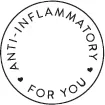![]()
LET US TELL YOU ABOUT Plato before we delve deeper into intestinal bacteria and inflammation. (Well, not exactly “us”; it’s Lina who will tell you about Plato. Mia is going to take this opportunity to paint her nails.)
Plato was born in Athens a few hundred years BC. He was a Greek philosopher, mathematician, and author, as well as the father of Platonism, which has contributed in many ways to Western philosophy. One example of Plato’s legacy is his idealism, which is part of the foundation of mathematical philosophy. Well, you can see for yourself that Plato wasn’t a few sandwiches short of a picnic.
A big part of Plato’s philosophy is known as Plato’s theory of ideas or forms. His theory encompasses two worlds, namely 1) the ideal (the perfect idea), and 2) the physical realm. According to Plato, nothing can exist in life without there also being a corresponding perfect idea (eternal, unchanging) of the same kind, in the world of ideas and forms.
For example:
When you walk past a vegetable garden and notice a potato, you think potato (if you don’t, make an appointment to see an eye doctor). You still recognize, with 100 percent certainty, that this is just a potato, even if it’s green and has begun sprouting. Plato says that this is because there is an ideal potato that all the potatoes in the real, tangible world strive to become, which is the reason you’d recognize the tuber as a potato, even if it were old and wrinkled.
– But Lina my dear, what does an old spud have to do with our book?
Mia screws the cap back onto the bottle of nail polish and blows on her nails. Lina looks at her.
– Hang on, I’m getting to the point soon.
Admittedly, Plato was mostly interested in mathematics, politics, and philosophy and not in potatoes, but we feel nonetheless that we can draw parallels with our relationship to food. Simply put, we could say that if the research and science presented in this book is in the realm of ideas, then we—our food-rejecting children and us and our cravings—are part of the real, material world. There exists an ideal, but there’s also a reality, which we often surrender to.
Mr. Plato
For instance, let’s say that all current research on food suggests that our intestinal flora would be at its happiest if we consumed twenty-two pounds of kale every day. We could call this “Plato’s Plate Model,” i.e., the idea of the perfect plate. In this ideal world, we would always eat twenty-two pounds of kale a day; however, in the real world that might end up being too big a challenge. First, most of us would probably find it difficult, not to mention a total drag, to choke down that much kale every day; and even if we were obstinate enough to try it, kale could be out of season, or the grocery store could be sold out. Second, we are humans and we have senses; if you add senses to the mix you’ll end up with a real mess. You’ll be attracted to the sight of a beautiful chocolate cake. Your sense of smell will be entranced by the aroma of freshly baked bread. The sound of a cork being pulled out of a bottle of wine will conjure up feelings of vacation and relaxation. Suddenly, there you are, gorging on a big piece of cake, working your way through a baguette, and downing several glasses of Bourgogne—even though none of these items are featured on Plato’s Plate.
Mia looks up from her coral nails.
– Wow, I’d love a glass of wine …
– Yes, but that just proves my point! Plato’s idealism is all about how it’s impossible to be perfect in the real world. It’s totally normal that we are unable to resist temptations; what would life be without them?
There is a prolonged silence. We hear the sound of a car passing in the street.
Before we started blogging about intestinal flora and inflammation, we were 1) thoroughly ruled by our senses, and 2) quasi-hypochondriacs. At the first smell of cardamom, we’d devour two buns with nary a thought; as soon as we heard the sparks of a fire being lit, we’d rush over to the grill, our sticks laden with marshmallows at the ready.
Then we’d head home, flip open our laptops, and read about how the rates of disease were rising all over the world; about how bad sugar was for our children; about how we got nowhere near enough fiber in our diets; and about how we’d all collapse suddenly and die if we so much as looked at a slice of bacon. It felt as though our lives were part of one big health lottery, where all we could do was close our eyes tightly, cross our fingers, and hope that we or anyone else we knew wouldn’t get sick.
But then we started to read and educate ourselves. The more we learned, the less we felt the grip of anxiety. Do you know why? Because knowing that there is an ideal we could strive for relieved us of our paranoia.
Slowly but surely, we realized that we might not just be part of one big health lottery after all, and that there is a compass out there. With that in mind, we suddenly gave ourselves permission to grab a snack to calm our senses. (Though things did get a bit out of hand—“Ahem, that’s the fifth day in a row you’re eating a slice of cake for dinner. That’s not exactly the best for your intestinal flora.”)
This is our reasoning:
1 Somewhere out there is a perfect plate (in the ideal world).
2 We know that not every meal from here on out will compare favorably to the perfect plate (but that’s okay, since we live in the real world).
3 But we will aim for the perfect plate, and we will try our best.
In other words, the research presented in this book is not a religion one must follow blindly. It is an ideal world we can keep in the back of our minds as we make our way through the real world full of cynical children, candy cravings, bellyaches, hunger pangs, broken hearts, and reward systems.
Another important thing to keep in mind is that what’s in this book is not etched in stone. If we could have assembled every physician, scientist, and journalist we have interviewed and been inspired by in one big room, they would have seen eye-to-eye on many things but would have also disagreed on quite a few issues, too—that’s a given. Research on intestinal flora is still in its infancy, but hopefully this book will give you a good picture of how food affects intestinal flora and show you in which direction the research is headed.
Learning about intestinal flora has been fun, but also a lot of work. Most of it is very logical, and it’s great to realize that there are so many things we can do to affect our bodies. However, it’s also a lot of work, because, well, it’s frustrating to realize that a lot of the stuff many of us consume daily makes us unwell, both physically and mentally. We live in a world that has completely lost its footing, and in the race to make food cheaper to manufacture, the food industry has made us dependent on a diet that our bodies are ill equipped for, which includes processed foods lacking in fiber, antioxidants, and minerals and that are loaded with added sugars, pesticide residues, and unhealthy fats. Add to that the easy availability of a huge range of convenience food, and we have the first generation in human history that is literally eating itself to death.
Even so, we generally feel that our bodies are fantastic. With help from Plato’s philosophy, we have come to realize that if we simply tune in to what our bodies require and make sure to give them plenty of nourishment each day, they will weather most storms. Select a few of the book’s recipes and start making them at even intervals, and you’ll be well on your way. Concentrate on all the wonderful things you’ll be giving your body rather than what you are giving up, and your stress will disappear. In the real world, we don’t agonize over eating an ice cream or that last margarita we drank. Sure, it won’t strengthen our intestinal flora, but if there is something we have learned, it is that intestinal flora does not thrive on anxiety. We suggest, once and for all, that we lay to rest all of our health worries and guilty consciences!
– How about it Mia, is it time for a small, welcome drink yet?
Mia stands up and straightens her velour sweatpants.
– You bet!
FOOD PHARMACY’S WELCOME SHOT
(makes 1 glass)
2/5 cup (100 ml) juice of your choice (if you’re hard core, go for plain water)
1 tbsp ground turmeric
½ tsp ground black pepper
1 tsp ground cinnamon
1 pinch ground cloves
1 tbsp apple cid...



